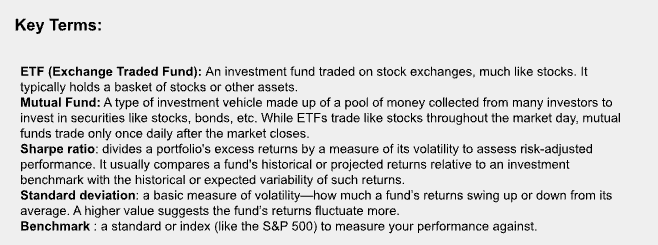


[Student IDEAS] by Laura Doledec - Master in Management at ESSEC Business School
This paper explores the rise of AI-labeled investment funds, which promise data-driven precision and freedom from human biases but often underperform traditional benchmarks like the S&P 500. While marketing hype and behavioral biases fuel investor enthusiasm, empirical evidence reveals mixed results, with challenges including overfitting, high costs, and model opacity. The study underscores the importance of skepticism, transparency, and due diligence in evaluating AI's true role in fund management.
---
In recent years, few trends in finance have captured the public imagination quite like AI-labeled investment funds. AI-labeled funds are investment funds that highlight the use of artificial intelligence or machine learning techniques in their portfolio construction process. They promise data-driven precision, predictive analytics for future trends, and real time monitoring that human managers are not able to do. These funds have proliferated since 2020, fueled by a blend of marketing promises, technological development and a broader cultural fascination with AI’s potential.
The oldest of these products, the AI Powered Equity ETF (AIEQ), launched in October 2017. Leveraging IBM Watson’s cognitive computing and deep learning, the algorithm ingests thousands of data to generate daily “buy” and “sell” signals, boasting:
• 34 daily signals for financial metrics
• 23 daily signals for news
• 17 daily signals for management factors
• 18 daily signals for macroeconomic indicators
On paper, it sounds like the fund of the future. In practice, AIEQ has underperformed the S&P 500 Index every single year since its inception. It also exhibits a lower Sharpe ratio and higher standard deviation than both its category peers and benchmark indices - suggesting it is riskier while delivering weaker returns. Despite this mixed track record, AIEQ quickly amassed over $130 million in assets under management, won an ETF.com award for “Best New Active ETF,” and is planning an international spin-off.
The story of this fund highlights the tension at the heart of AI-labeled funds: a marketing triumph on one hand with a lot of excitement from investors, and on the other, a so-so performance record. Are we on the brink of an investing revolution, or are we merely falling for a new hype?

An AI-labeled fund markets its use of artificial intelligence or machine learning to inform portfolio choices. Specific applications vary widely:
The extent to which funds use AI really depends. It can range from rudimentary sentiment-screeners to purportedly advanced deep learning models that perform natural-language processing or image recognition. However, managers often keep their methods opaque, citing proprietary concerns.
By contrast, traditional, human-managed funds rely primarily on professional money managers and analysts. These individuals combine:
Some traditional funds incorporate quantitative methods, but generally the focus remains on human judgment and domain expertise.
| Dimension | AI-Labelled Funds | Traditional Funds |
| Decision Making | Algorithmic (rules-based, data-driven) | Human managers (experience-based, interpretive) |
| Transparency | Often opaque “ black box” systems | More transparent processes and rationales |
| Costs & Turnover | Potentially lower expense ratios but can incur higher trading costs if turnover is high | Often higher management fees, but trading frequencies vary |
| Biases | Less vulnerable to human overconfidence or herding, but can overfit data | Prone to emotional biases, but can exercise human discretion in usual market conditions |
AI funds often highlight three main advantages over human managers:
On the flip side, disadvantages -that these funds do not advertise- include:
Despite these theoretical disadvantages, AI-Labeled funds - and AI in general - arouse a lot of excitement among the public. There are a few psychological factors that could explain the adoption of AI-labelled funds: the “halo effect”, novelty bias, fear of missing out (FOMO), overconfidence in algorithms, herding and the barnum effect.
Investors often perceive data, algorithms, and machine learning as objective truth, free from the human tendencies of overconfidence and poor judgment. Consequently, AI-labeled funds enjoy a psychological “halo effect,” where their high-tech veneer can inspire trust—even if actual returns are inconclusive.
Finance is no stranger to the “next big thing,” from the Internet bubble to algorithmic trading in the 1990s. AI is only the latest in a long line of technologies marketed as revolutionary. Novelty bias leads some investors to adopt new solutions—sometimes uncritically—out of FOMO on an exciting innovation.
A dangerous assumption is that software must be either “incredibly smart” or completely ineffective. In reality, AI’s performance depends heavily on model design, quality of data, and the specifics of a given market environment.
Just as in other high-tech sectors, marketing for AI-labeled funds can be vague but aspirational (“Our deep-learning model personalizes your financial journey!”). Investors who believe these generalized claims may see themselves in the fund’s story—even when the product is not materially different from other quantitative strategies. This phenomenon is known in academia as the barnum effect. Additionally, investor herding—buying in because “everyone else is doing it”—can amplify inflows, reinforcing the sense of a promising new technology without requiring objective performance data.
Empirical studies - such as those by Chen and Ren [4], Praxmarer and Iván Simon [7] - have yielded mixed findings. While some show that AI-labeled funds can slightly outperform comparable human-managed funds (often because of lower transaction costs or reduced behavioral biases), this outperformance often disappears when:
In fact, AIEQ’s underperformance relative to the S&P 500 has been notable, showcasing that not all AI-driven funds deliver better results than passive index strategies (ETFs).
A key limitation of AI is overfitting, wherein an algorithm that looks brilliant when back tested on historical data might fail in real-world conditions. Markets can shift from bullish to bearish regimes swiftly, making yesterday’s patterns irrelevant.
Signal-to-Noise Ratio1 in financial markets is often low, and many “anomalies” that an AI uncovers turn out to be fleeting coincidences.
Interestingly, some investors assume AI-labeled funds are “safer” because of their algorithmic rigor. Yet as AIEQ demonstrates with its higher standard deviation, AI can sometimes increase volatility by aggressively reallocating or overreacting to short-term data. High-speed automated trades may also exacerbate flash crashes. While AI-labelled funds can erase risks that are inherent to traditional funds such as human biases, managerial turnover and higher fee structure, they also have risks of their own: technical failures, model opacity and data dependence.
Some investors are drawn to the perceived infallibility of algorithms, while others remain more comfortable with a seasoned money manager who can articulate a “story” behind each stock pick. Both positions are subject to biases:
The marketing around AI-labelled funds, and AI in general, differs from traditional fund marketing. Marketers of AI-labelled funds often emphasize terms like “deep learning", “cutting edge algorithms” to promote an image of unstoppable progress.
The public sees headlines about AI beating grandmasters at chess or diagnosing diseases faster than doctors. Fund marketers capitalize on these achievements, suggesting that similar AI breakthroughs apply seamlessly to stock picking—though the conditions for success differ greatly across domains.
Moreover, AI-labeled funds frequently do not publish transparent performance-attribution analysis. Investors often have only a rosy marketing narrative, which inflates expectations and fosters a mismatch between perceived and actual capability.
As AI’s role in financial decisions grows, so do calls for regulatory oversight. Concerns include:
Regulators may soon require clearer disclosures about how AI-driven decisions are made and what risks they carry.
Moreover, one major obstacle to fully assessing AI-powered funds is the lack of transparency around the use of AI in the investment process. This opacity prevents investors -and researchers- from systematically comparing different approaches, isolating the factors that drive performance, and learning from the successes or failures of AI integration. Without clear disclosures, the investment is left speculating about how these funds truly operate under varying market conditions.
Implications for Investors and the Financial Industry
For prospective investors, the best defense against AI hype is good old-fashioned due diligence. Consider the following questions:
Skepticism is not cynicism. AI tools can indeed deliver advantages, especially in filtering massive datasets or automating routine tasks. Cao et al. in [2] for example showed that AI is more likely to outperform human analysts when the amount of public information is substantial. Nonetheless, the complexity of financial markets means that no single tool—human or machine—can guarantee consistent alpha.
In practice, the “black box” defense for AI-labeled funds can make it difficult for investors to evaluate:
While trade secrets are understandable, clearer communication would help investors and regulators alike distinguish truly innovative AI usage from superficial marketing.
Are AI-labeled funds inherently superior? The short answer: Not necessarily. Although they harness impressive computational power and claim to avoid human biases, AI-labeled funds face their own pitfalls—overfitting to historical data, higher hidden costs, and potential for outsized volatility when markets shift. Despite underwhelming performance records, some AI-driven products have nonetheless attracted significant assets under management, thanks in part to investor fascination with all things “tech” and a savvy marketing playbook.
The bottom line is that AI is not an automatic pass to superior returns. Investors should be careful and should apply a healthy dose of skepticism. Scrutinizing performance data, risk metrics, cost structures, and model transparency is crucial to separating the truly game-changing innovations from yet another buzzword. In a realm as complex and adaptive as financial markets, neither human wisdom nor machine intelligence can claim all the answers—yet informed, diligent investors can benefit from the best of both worlds.
1Signal-to-Noise Ratio (SNR) is a concept used by investors to quantify the relevance of data/indicators they use in their investment process. A high SNR implies that the signal (useful information) is stronger than the noise (irrelevant data), providing more confidence in the reliability of the information.
[1] Ariely, D., 2008. Predictably Irrational: The Hidden Forces That Shape Our Decisions. Choice Reviews Online, 46(02), 46‑0969. Available at: https://doi.org/10.5860/choice.46-0969
[2] Cao, S., Jiang, W., Wang, J. and Yang, B., 2021. From Man vs. Machine to Man + Machine: The Art and AI of Stock Analyses. NBER Working Paper. Available at: https://doi.org/10.3386/w28800
[3] Chen, A.Y. and Velikov, M., 2022. Zeroing in on the Expected Returns of Anomalies. Journal of Financial and Quantitative Analysis, 58(3), pp.968–1004. Available at: https://doi.org/10.1017/s0022109022000874
[4] Chen, R. and Ren, J., 2021. Do AI-powered mutual funds perform better? Finance Research Letters, 47, Article 102616. Available at: https://doi.org/10.1016/j.frl.2021.102616
[5] Malkiel, B.G., 2023. A Random Walk Down Wall Street. W.W. Norton & Company.
[6] Parveen, S., Satti, Z.W., Subhan, Q.A. and Jamil, S., 2020. Exploring Market Overreaction, Investors’ Sentiments and Investment Decisions in an Emerging Stock Market. Borsa Istanbul Review, 20(3), pp.224–235. Available at: https://doi.org/10.1016/j.bir.2020.02.002
[7] Praxmarer, M. and Simon, I., 2024. Assessing the Performance of AI-Managed Portfolios. SSRN Electronic Journal. Available at: https://doi.org/10.2139/ssrn.5037553
[8] Zhang, W., 2022. Do Mutual Funds Benefit from the Adoption of AI Technology? Research report. Available at: https://papers.ssrn.com/sol3/papers.cfm?abstract_id=4871159
(Additional sources include ETF.com, Dividend.com, academic working papers, and white papers from asset management firms.)